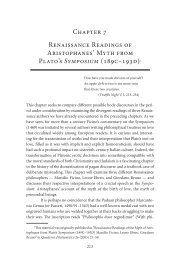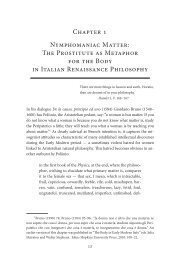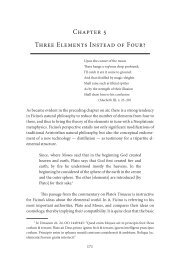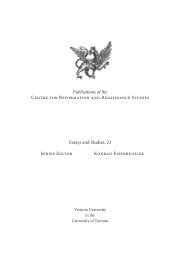Chapter 2 Matter as a Mirror: Marsilio Ficino and Renaissance ...
Chapter 2 Matter as a Mirror: Marsilio Ficino and Renaissance ...
Chapter 2 Matter as a Mirror: Marsilio Ficino and Renaissance ...
Create successful ePaper yourself
Turn your PDF publications into a flip-book with our unique Google optimized e-Paper software.
<strong>Matter</strong> <strong>as</strong> a <strong>Mirror</strong> 49<br />
<strong>as</strong> forebears of the truths of Christian doctrine. 3 <strong>Ficino</strong>’s translation of Plato<br />
adhered closely to the original text <strong>and</strong> w<strong>as</strong> therefore highly influential well<br />
into the nineteenth century. 4 To write about the concept of matter <strong>and</strong> its<br />
relationship to gendered ide<strong>as</strong> in the works of a <strong>Renaissance</strong> Platonist will<br />
perhaps seem strange at first, especially since <strong>Ficino</strong> is known mainly <strong>as</strong> a<br />
‘doctor of souls,’ <strong>and</strong> <strong>as</strong> the promulgator of the intricate metaphysics expressed<br />
in the system of hypost<strong>as</strong>es by Plotinus, Proclus <strong>and</strong> other Neoplatonists.<br />
5 Being ‘the shadow of a shadow,’ ‘a corpse adorned,’ ‘evil itself ’ (to<br />
quote Plotinus), matter is either not mentioned at all in such Neoplatonic<br />
hierarchies or else it is unmistakably placed on the lowest level in the scale<br />
of being. 6 And indeed, neither matter nor women are prominent topics in<br />
<strong>Ficino</strong>’s writings. Nevertheless, <strong>Ficino</strong>’s cosmology, <strong>as</strong> well <strong>as</strong> his metaphysics,<br />
refer implicitly (<strong>and</strong> hence perhaps even more decisively for this philosophy)<br />
to a gendered substructure: the partition of creation into male<br />
<strong>and</strong> female <strong>as</strong>pects. This becomes especially obvious in <strong>Ficino</strong>’s ide<strong>as</strong> about<br />
matter, which he inherits <strong>and</strong> transforms from a complex amalgamation<br />
of divergent traditions from Cl<strong>as</strong>sical Antiquity. During the p<strong>as</strong>t decades,<br />
scholars such <strong>as</strong> Evelyn Fox-Keller have sought to make this gendered <strong>and</strong><br />
highly metaphorical discourse explicit; a mode of thinking that pervades<br />
even modern science to an amazing degree:<br />
[…] gender <strong>and</strong> norms come to be seen <strong>as</strong> silent organizers<br />
of the mental <strong>and</strong> discursive maps of the social <strong>and</strong> natural<br />
worlds we simultaneously inhabit <strong>and</strong> construct even in those<br />
worlds that women never enter. I call this the symbolic work<br />
3 Copenhaver (1992) 155; Allen (1984) p<strong>as</strong>sim.<br />
4 For a positive <strong>as</strong>sessment of the quality of <strong>Ficino</strong>’s translations, see Hankins (1990)<br />
1: 311–313.<br />
5 Allen (1982) 19: “Indeed, the whole philosophy of Plotinus, the founder of Neoplatonism,<br />
is a consequence of his dividing reality into a hierarchical series of ontological states<br />
where the higher subsumes the lower <strong>and</strong> the lower emanates from the higher <strong>and</strong> ultimately<br />
prime hypost<strong>as</strong>is, the transcendent one.” For a clear exposition of the hierarchy of being by<br />
<strong>Ficino</strong> himself, see <strong>Ficino</strong> (1975) chapt. 4: 88–102. The relevant p<strong>as</strong>sages from Plato are Laws<br />
X, 892A; 896A–898B; Parmenides 137C–142D <strong>and</strong> 159B–160B. For a detailed exposition of<br />
Plotinus’ system of hypost<strong>as</strong>es, see for example, Armstrong (1940) p<strong>as</strong>sim.<br />
6 See O’Brien (1996) 182–184, with references.







